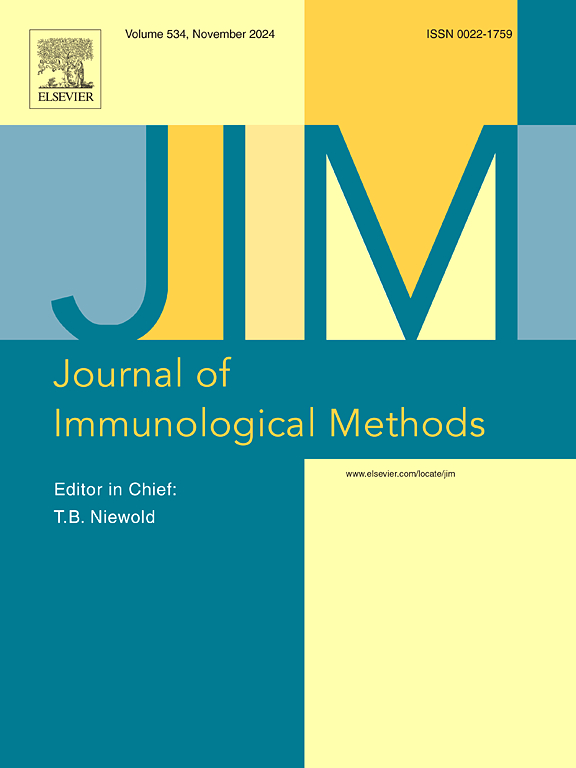小鼠单克隆抗体 4E3 对人类 IgG1 的 G1m17 异型具有特异性。
IF 1.6
4区 医学
Q4 BIOCHEMICAL RESEARCH METHODS
引用次数: 0
摘要
异型是免疫球蛋白异型中的一种氨基酸变异。人类 IgG1 有四种异型,其中两种(G1m3 和 G1m17)位于γ 链 CH1 区域的 214 位。各种疾病都与异型表达有关,因此异型研究成为免疫学中一个有趣的领域。然而,异型特异性试剂并不多见。在本研究中,我们评估了一种名为 4E3 的 IgG1 特异性单克隆抗体的特异性,该抗体被描述为与 IgG1 的铰链区结合。使用 ImmunoCAP™ 检测技术,在 23 份人体血清和血浆样本中,有 13 份样本在使用 4E3 作为检测试剂的抗体-酶结合物时竟然没有检测到 IgG1。使用八种 IgG1 骨髓瘤副蛋白对 4E3 进行进一步评估后发现,4E3 与其中三种副蛋白没有结合。结合模式与骨髓瘤轻链糖基化或卡帕链或轻链使用之间没有关联。通过比较 4E3 和 TM14(一种已知具有 G1m3 特异性的单克隆抗体)的骨髓瘤副蛋白结合模式,表明 4E3 只与表达 G1m17 异型的骨髓瘤副蛋白结合。使用表达 G1m3 或 G1m17 所有型的重组人抗体证实了这一点。在基于微孔板的酶联免疫吸附试验中也观察到了使用 ImmunoCAP 发现的 4E3 的 G1m17 偏倚。抗体 4E3 的 G1m17 偏倚限制了它在检测 IgG1 抗体时的应用。不过,它可能是一种有价值的异型特异性试剂。本文章由计算机程序翻译,如有差异,请以英文原文为准。
The mouse monoclonal antibody 4E3 is specific for the G1m17 allotype of human IgG1
Allotype is an amino acid variation within the immunoglobulin isotypes. Four allotypes have been described for human IgG1 and two of them (G1m3 and G1m17) are located at position 214 in the CH1 region of the gamma chain. Various diseases have been associated with allotype expression, making the allotype research an interesting field in immunology. However, allotype-specific reagents are rare. In the present study the specificity of a widely used and commercially available IgG1-specific monoclonal antibody named 4E3, described as binding to the hinge region of IgG1, was evaluated. Using the ImmunoCAP™ assay technology, surprisingly no IgG1 was measured in 13 of 23 human serum and plasma samples when 4E3 was used in an antibody-enzyme conjugate as detection reagent. Further evaluation of 4E3 using eight IgG1 myeloma paraproteins revealed that 4E3 did not bind to three of them. No association was seen between the binding pattern and myeloma light chain glycosylation or the kappa or light chain use. By comparing the myeloma paraprotein binding patterns of 4E3 and TM14 (a monoclonal antibody with known G1m3 specificity), it was indicated that 4E3 only bound to myeloma paraproteins expressing the G1m17 allotype. This was confirmed using recombinant human antibodies expressing either the G1m3 or G1m17 allotype. The G1m17 bias of 4E3 seen using ImmunoCAP was also observed in microtiter plate-based enzyme-linked immunosorbent assays. The antibody 4E3 has a G1m17 bias limiting its use in assays to measure IgG1 antibodies. However, it may be a valuable allotype-specific reagent.
求助全文
通过发布文献求助,成功后即可免费获取论文全文。
去求助
来源期刊
CiteScore
4.10
自引率
0.00%
发文量
120
审稿时长
3 months
期刊介绍:
The Journal of Immunological Methods is devoted to covering techniques for: (1) Quantitating and detecting antibodies and/or antigens. (2) Purifying immunoglobulins, lymphokines and other molecules of the immune system. (3) Isolating antigens and other substances important in immunological processes. (4) Labelling antigens and antibodies. (5) Localizing antigens and/or antibodies in tissues and cells. (6) Detecting, and fractionating immunocompetent cells. (7) Assaying for cellular immunity. (8) Documenting cell-cell interactions. (9) Initiating immunity and unresponsiveness. (10) Transplanting tissues. (11) Studying items closely related to immunity such as complement, reticuloendothelial system and others. (12) Molecular techniques for studying immune cells and their receptors. (13) Imaging of the immune system. (14) Methods for production or their fragments in eukaryotic and prokaryotic cells.
In addition the journal will publish articles on novel methods for analysing the organization, structure and expression of genes for immunologically important molecules such as immunoglobulins, T cell receptors and accessory molecules involved in antigen recognition, processing and presentation. Submitted full length manuscripts should describe new methods of broad applicability to immunology and not simply the application of an established method to a particular substance - although papers describing such applications may be considered for publication as a short Technical Note. Review articles will also be published by the Journal of Immunological Methods. In general these manuscripts are by solicitation however anyone interested in submitting a review can contact the Reviews Editor and provide an outline of the proposed review.

 求助内容:
求助内容: 应助结果提醒方式:
应助结果提醒方式:


